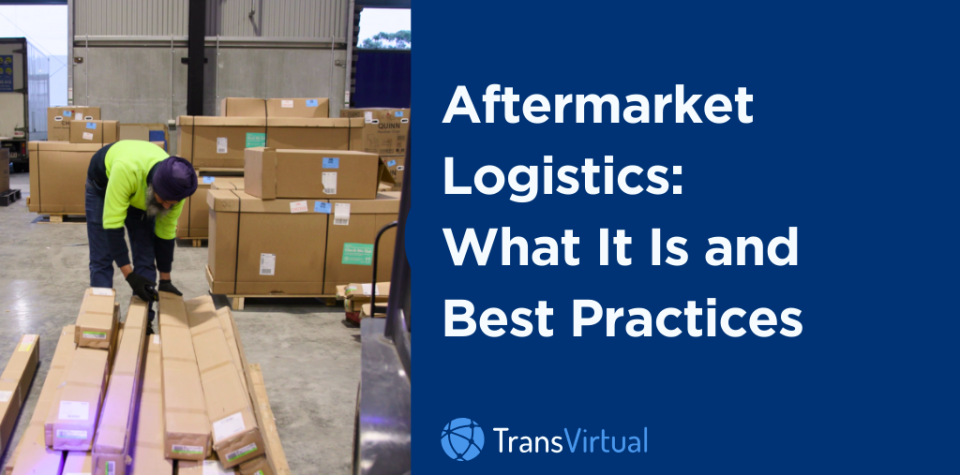Table of Contents
The sale is just the beginning. But after you deliver the goods, what happens next can make or break your reputation, affect customer loyalty, and impact your bottom line significantly.
This is aftermarket logistics, the key to enhancing customer satisfaction and loyalty.
Think of aftermarket logistics services as a set of practices designed to keep customers coming back long after their initial purchases. From managing returns and repairs to ensuring availability of spare parts, if you maintain a streamlined aftermarket logistics strategy, you’ll find building your success that much easier.
Today, we’ll take a closer look at the components of an effective aftermarket logistics strategy and the best practices for optimising those processes. Let’s get started.
What is Aftermarket Logistics?
Aftermarket logistics, sometimes known as post-sales logistics, is the process of managing the flow of goods and services after the initial sale. Practices involved include maintenance, repair, overhaul of products, returns, warranties, spare parts, etc. This differs from forward logistics because it deals with the reverse flow of products from customers to manufacturers and service providers. It’s often far more complex and unpredictable as a result.
An effective aftermarket logistics strategy is crucial for your brand’s reputation and customer satisfaction. Many industries where aftermarket logistics is more prominent see significant portions of revenue and profit margins stemming from these services. If you can provide efficient and reliable aftermarket support in your supply chain, your company can differentiate yourself from competitors, generate more recurring revenue streams, and optimise your supply chain efficiency.
Key Processes & Factors in Aftermarket Logistics
Your aftermarket supply chain management processes will typically include reverse logistics and returns management, spare parts management and distribution, warranty management, etc.
Reverse logistics focuses on efficiently managing the return flow of products from customers back to manufacturers – this means handling returns, repairs, refurbishments, and disposals.
Spare parts management is about ensuring the right parts are available to support product maintenance and repairs – it involves forecasting demand, managing inventories, and optimising distribution networks.
Warranty management involves setting customer expectations and ensuring consistent deliveries according to your service level agreements.
Lets use the automotive industry as an example. With the help of effective aftermarket logistics providers, garages and shops can give customers quick access to automotive aftermarket parts from original equipment manufacturers (OEM) or aftermarket parts.
Effective aftermarket supply chain management requires your business to coordinate and integrate these processes alongside real-time data sharing and collaboration between all stakeholders. These might include other logistics providers, service teams, suppliers, customers, etc.
If you take a more holistic approach and leverage technologies like modern transportation management software, IoT, predictive analytics, automation, and more, your company can optimise services, get real-time visibility into the entire supply chain, reduce inventory costs, and meet customer expectations.
How You Can Develop an Effective Aftermarket Logistics Strategy
1. Streamline Returns Management
Implement a clear and customer-friendly returns policy that outlines conditions, time frames, and procedures. Then, offer convenient return options like online portals, pre-printed shipping labels, and drop-off locations that make the process seamless for your customers.
You should also ensure the returns process is easy to initiate and complete from start to finish to encourage long-term customer satisfaction.
2. Invest in Technology
Find and implement an inventory management system that provides real-time visibility into spare parts availability, locations, and demand to help you properly forecast and provide faster order fulfillment.
You can automate your returns processing using technologies like barcode scanning, RFID, and mobile apps to reduce human errors and accelerate credit processing and refunds. Remember to leverage data analytics often to help your business identify trends and bottlenecks along with improvement areas to enable more data-driven decision-making.
3. Commit to Continuous Improvement
Regularly analyse data you collect on reasons for returns, frequencies, and patterns to identify underlying issues and trends. Use the information gathered to improve product quality, enhance instructions for users, and adjust your marketing strategies to minimise avoidable returns in the future.
Take your customer feedback, survey data, and analyse social media sentiment to gauge customer satisfaction and identify particular pain points in their aftermarket experiences. Be proactive about addressing customer concerns, always seeking ways to improve your service quality and reduce the likelihood of further returns or complaints.
4. Focus on Data & Optimisation
Take the most data-driven approach possible to optimising your processes, using technology and data analytics to gain insights that help you adapt to changing customer needs and market conditions. Seek new ways to improve your service quality, reduce costs, and enhance customer satisfaction by identifying opportunities for process improvement and automation.
Optimise Your Aftermarket Logistics Process with TransVirtual
At TransVirtual, we offer a suite of logistics software solutions that streamline aftermarket operations for our clients. Since our team thoroughly understands the unique challenges of aftermarket logistics, we’ve provided a range of features in our transportation management software, including automated returns processing, real-time inventory visibility, seamless integration with carriers and partners, and much more.
By taking advantage of the advanced technology and expertise of the TransVirtual team, your company can:
Reduce manual data entry and errors through API integrations with existing systems
Gain end-to-end visibility throughout the entire aftermarket journey
Automate key processes like returns management, spare parts distribution, and warranty claims handling
Utilise data analytics to identify trends, optimise inventory, and make more informed decisions
Improve customer satisfaction by providing rapid, transparent, and reliable aftermarket support
If you’re ready to optimise your aftermarket logistics strategy, it’s time to schedule a personalised strategy session with an expert at TransVirtual today. We’ll work closely with you to understand your unique needs and identify opportunities for improvement. Then, we’ll develop a tailored solution that drives results for your business.



